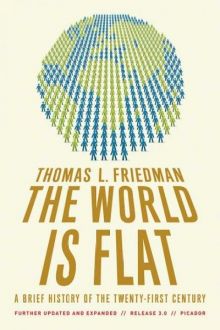 In The World is Flat, Thomas Friedman, foreign affairs columnist for the New York Times, describes how the world has become a more equal playing field to many of its people and the resulting implications. Friedman begins his book by giving examples of global out-sourcing and the extent of global communication. He explains how new technology has resulted in creating a level playing field, or a “flat world,” for workers in other countries. He then seeks to explain how this has happened. Friedman lists and describes the ten “flatteners” that created the flat world. These include the fall of the Berlin wall and the rise of Microsoft Windows, the release of Netscape, work flow software, open-sourcing, outsourcing, offshoring, supply-chaining, insourcing, in-forming, and the “steroids,” – those things that made made the other “flatteners” more digital, mobile, personal, and virtual.
In The World is Flat, Thomas Friedman, foreign affairs columnist for the New York Times, describes how the world has become a more equal playing field to many of its people and the resulting implications. Friedman begins his book by giving examples of global out-sourcing and the extent of global communication. He explains how new technology has resulted in creating a level playing field, or a “flat world,” for workers in other countries. He then seeks to explain how this has happened. Friedman lists and describes the ten “flatteners” that created the flat world. These include the fall of the Berlin wall and the rise of Microsoft Windows, the release of Netscape, work flow software, open-sourcing, outsourcing, offshoring, supply-chaining, insourcing, in-forming, and the “steroids,” – those things that made made the other “flatteners” more digital, mobile, personal, and virtual.
The next section looks at how the US should react to a flat world. He encourages American workers to work harder and develop more knowledge and creative jobs that cannot be as easily outsourced. He outlines recommendations for educational, economic, and political changes that the US should make to remain a world leader. Friedman then turns his focus to the underdeveloped world and the Islamic world. He looks at the reasons that opportunities are limited in these nations and what could be done so that the individuals in these nations can enter the flat world. He looks at global politics and causes of terrorism.
Citing numerous examples and drawing from his vast wealth of personal interviews, Friedman illustrates his points with skill. He uses examples from corporations, both large and small, governments, and non-governmental organizations to explain how the flat world principles work. This book explains what we see happening in the world around us and show how recent breakthroughs fit together like puzzle pieces to form our modern world. He explains why certain things that may seem insignificant are actually major shifts that have shaped the last fifteen years. Applications may be made in political, vocational, religious, and organizational facets of life.